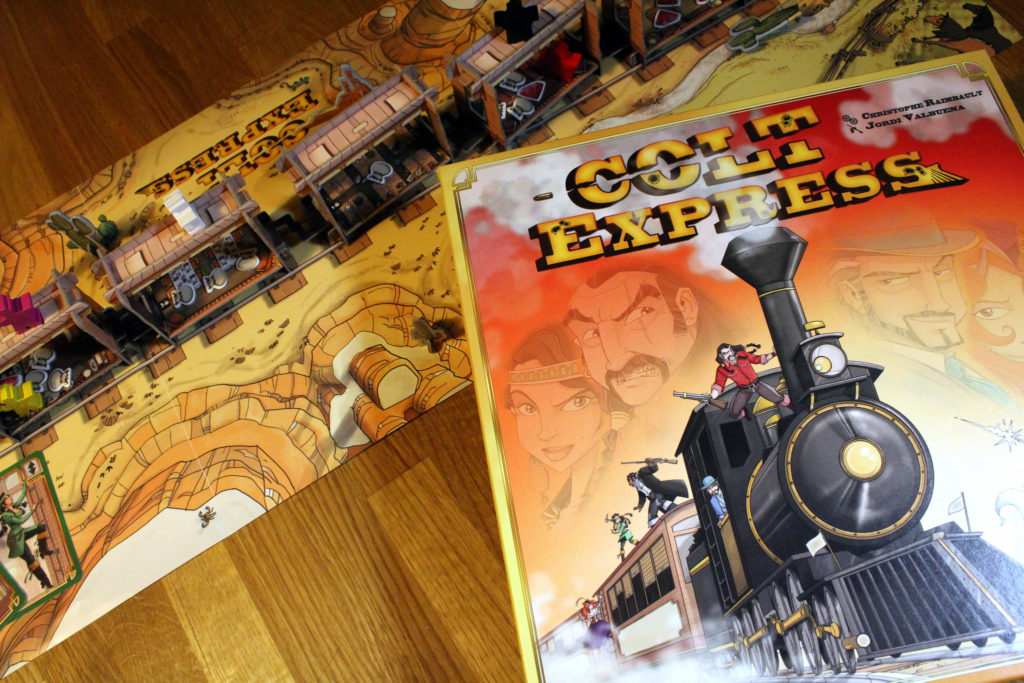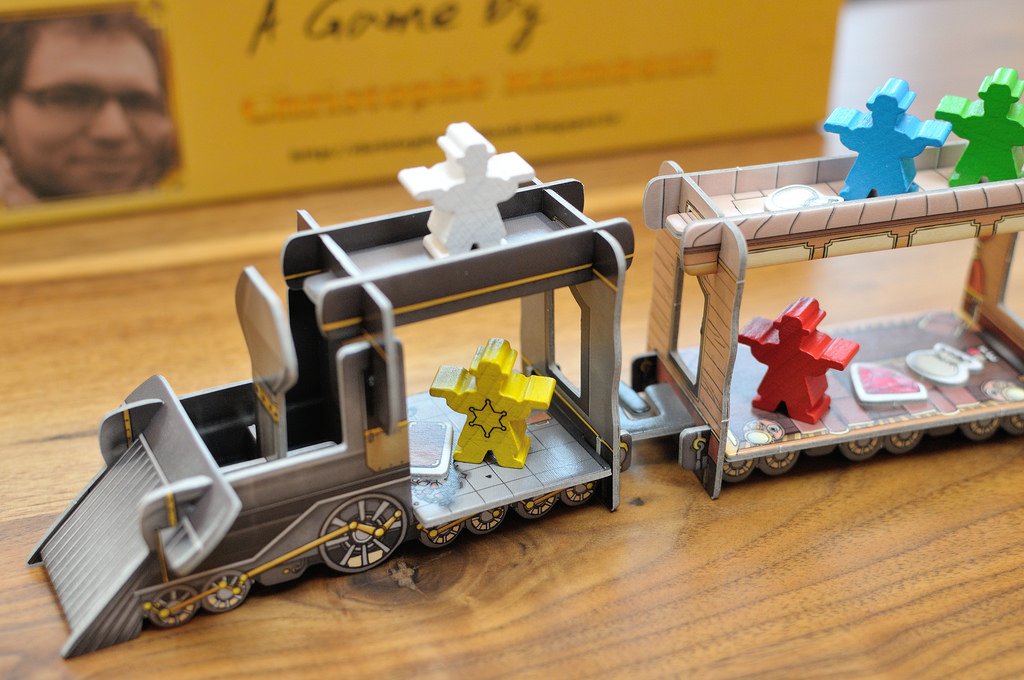Becoming a game developer/blogger was my second career choice. In my heart of hearts, I’m a cowboy and a bandit. Despite an upbringing in the American Southeast, I shoot like that one guy in Blazing Saddles. It was therefore my great pleasure and fortune to be able to play out my Sergio Leone film fantasies at the game table of my friendly local gaming store.
Need help on your board game?
Looking for more resources to help you on your board game design journey?
Colt Express is a popular game with a resume loaded with accolades like Spiel des Jahres Winner and several Golden Geek nominations. It’s no surprise when you play it on the table! It’s innovative both in its gameplay and in its presentation, which involves a 3D train and clever use of verticality which you don’t often see in the Flatland of board gaming.

It’s a pretty lightweight game, so it’s easy to explain the rules. Between 2 and 6 people can play and it takes roughly half an hour. You play as a bandit with the singular focus of doing what bandits do best: chasing sweet, sweet money. This money comes in the form of suspicious bags of cash, giant rubies, and Pulp Fiction suitcases. This cash is represented by components which are scattered across the train.
So far, so simple. This is where things get interesting. You and your opponents must choose your moves in advance for an entire round. You and your opponents all have ten cards for six possible moves: grab money, shoot someone, punch someone, move side to side, move vertically – from the cabin to the roof or vice versa, or call the marshal. You draw six of these ten cards. Then you and your opponents take turns playing cards until you’ve played four from your hand for the round. At the end of the round, you get your cards back, shuffle them up, and draw another six cards. After a few rounds, the game is over and you count your cash.
You determine what moves you’re going to make in advance of the round. Because of this dynamic, Colt Express is a programmable movement game. For the purpose of this breakdown’s coherence, I won’t go into details of the shooting and marshal mechanics, nor will I cover the end-game shooting bonus. I’m going to focus on the programmable movement, because this mechanic alone has a lot of subtle implications which I will proceed to break down.

Colt Express encourages players to plan
Colt Express would be a very boring game if it were a one-player affair. You could tell your player exactly where to go, what to do, and when to pick up cash. Yet with other players in the mix, you introduce all sorts of fascinating variables. Players can pick up money before you get to it – making you waste an action by trying to pick up cash that isn’t there. Your movement could be thwarted by someone shooting you and knocking you back somewhere else. If a series of events conspires against you, you might end up walking into the marshal by mistake. Whoopsy-daisy.
It’s all these unknowns that make you have to not just play the game, but play the players. You have to anticipate what other people are doing. You have to guess their motivations. On rounds where everybody plays their cards face-up, this is easy. However, sometimes, you go through “tunnels”, which causes everyone to play their action cards facedown. When cards are face-up, you have to think on the fly. When cards are facedown, you have to think in advance.
There’s a larger subgame as well, because stacking cash too early can make you a target. Ideally, you want to come from behind so no one anticipates your actions.
Colt Express takes a mechanic with complex possibilities and uses its physical setup to teach players
Colt Express uses it components, its setup, its art, and its theme to really sell programmable movement in a way that feels perfectly sensible. Imagine yourself as a neophyte gamer for a moment. Programmable movement is a strange concept. New board gamers might liken it to a more extreme version of the dynamics found in Pokemon or old school Paper Mario. Yet in Colt Express, it never feels weird or awkward – even to new gamers I’ve played with.

The pretty train in Colt Express isn’t just for show or sales. Using three dimensions helps new players visualize their moves. It helps people to think four moves in advance, as they must in Colt Express. The theme also helps, since the idea of bandits stealing cash makes perfect sense as a narrative.
Consider for a moment how Colt Express would function differently as a 2D game. You could totally do it and it’d still be a great game! Just make a board with the two levels of the train depicted as different rows. It’s not hard to imagine…but it wouldn’t have the same staying power as a teaching tool. Some people learn well in the abstract, but others excel with spatial reasoning. Colt Express uses its rules, its theme, and its physical shape to reach out to different people who have different ways of processing information. That’s why it can sell a weird concept like movement programming in a lightweight game.

Colt Express is available on Amazon for $35.99. I definitely recommend that you check it out. It’s not just a great teaching tool for itself, but it’s a great teaching tool for design as well.






2 thoughts on “Colt Express: Making Players into Planners”